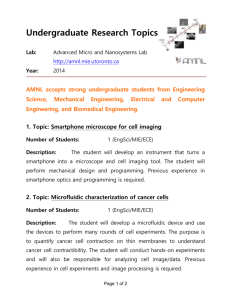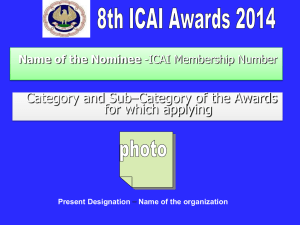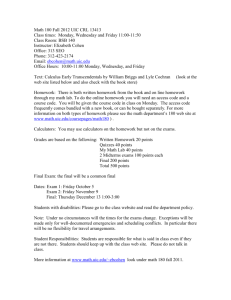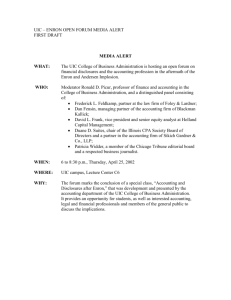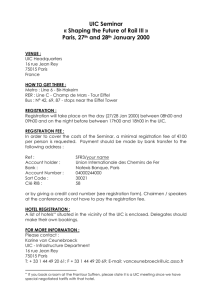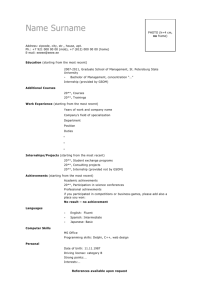UIC_RTN_Original_Qua.. - University of Illinois at Chicago
advertisement
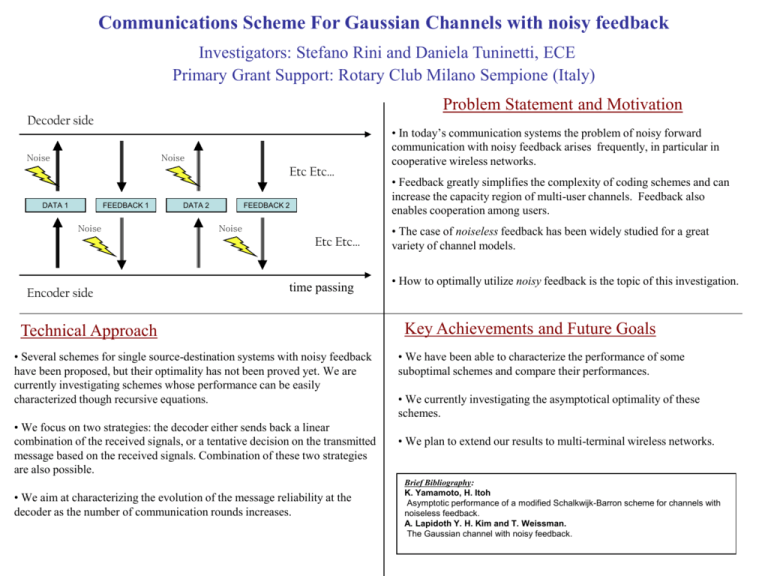
Communications Scheme For Gaussian Channels with noisy feedback Investigators: Stefano Rini and Daniela Tuninetti, ECE Primary Grant Support: Rotary Club Milano Sempione (Italy) Problem Statement and Motivation Decoder side Noise Noise Etc Etc… DATA DATA11 FEEDBACK FEEDBACK11 Noise DATA 2 FEEDBACK FEEDBACK12 Noise Etc Etc… Encoder side time passing Technical Approach • Several schemes for single source-destination systems with noisy feedback have been proposed, but their optimality has not been proved yet. We are currently investigating schemes whose performance can be easily characterized though recursive equations. • We focus on two strategies: the decoder either sends back a linear combination of the received signals, or a tentative decision on the transmitted message based on the received signals. Combination of these two strategies are also possible. • We aim at characterizing the evolution of the message reliability at the decoder as the number of communication rounds increases. • In today’s communication systems the problem of noisy forward communication with noisy feedback arises frequently, in particular in cooperative wireless networks. • Feedback greatly simplifies the complexity of coding schemes and can increase the capacity region of multi-user channels. Feedback also enables cooperation among users. • The case of noiseless feedback has been widely studied for a great variety of channel models. • How to optimally utilize noisy feedback is the topic of this investigation. Key Achievements and Future Goals • We have been able to characterize the performance of some suboptimal schemes and compare their performances. • We currently investigating the asymptotical optimality of these schemes. • We plan to extend our results to multi-terminal wireless networks. Brief Bibliography: K. Yamamoto, H. Itoh Asymptotic performance of a modified Schalkwijk-Barron scheme for channels with noiseless feedback. A. Lapidoth Y. H. Kim and T. Weissman. The Gaussian channel with noisy feedback. Protocols of Gaussian Fading Channel Investigators: Yang Weng, Daniela Tuninetti, ECE; Prime Grant Support: NSF CAREER 0643954 Problem Statement and Motivation •In wireless peer-to-peer networks, the signal by mobile users experienced wide fluctuations due to fading and interference. • Orthogonalization techniques, such as TDMA (time division multiple access), although leading to simple network architectures, can be very suboptimal in terms of achievable rates. •We propose communication strategies that improve network throughout over TDMA, especially at low SNR (signal to noise ratio). Technical Approach • We consider a network of interference channels, where the receiver signal at receiver is Key Achievements and Future Goals • We derived inner and outer bounds for the capacity of the fading interference channels. • The bounds are compared in the limit for high-SNR. where are Gaussian, white and, without of generality with unit power. represent the channel gain while inputs are limited to power . •Our goal is to determine the outage capacity of the above network when the instantaneous fading state is unknown to the transmitters. This scenario is relevant in ad-hoc network with user’s mobility. • We find that, opposed to the un-faded case, the outer and the inner bounds do not always coincide. • We plan to extend our results to networks with more than two users. Brief Bibliography: Y. Weng, D. Tuninetti ”Outage analysis of Block-Fading Gaussian Interference Channels”, 2009 SPAWC, June 2009, Perugia, Italy. Cooperative Interference Channels Investigators: Echo Yang and Daniela Tuninetti, ECE; Prime Grant Support: NSF CAREER Problem Statement and Motivation • In wireless networks, concurrent communications interfere with each other. Due to the broadcast nature of the wireless media, a sender can sense the channel and use the overhead information cooperate with other users. • Cooperative communications allow to increase the achievable rates of all the users without increasing the transmit power. • We study communication strategies that combined ideas from relaying, broadcasting and multiaccess. Technical Approach • We assume that senders use the overheard information to partially decode the information sent by the other users. • The transmitters then cooperatively send those data streams that are decoded at all receivers by forming a virtual multi antenna transmitter. •Each transmitter that has decoded data non intended for its receiver, uses Dirty Paper Coding to pre-code the intended data against the interference produced by the non-intended data. Key Achievements and Future Goals • Recently we have determined an achievable region that combines and simplifies known achievable regions. • We are currently studying the optimality of our proposed scheme. • We plan to extend our results to large networks. Brief Bibliography: Y. Weng, D. Tuninetti A new achievable region for interference channels with generalized feedback, CISS 2008, Princeton, NJ, March 2008. Energy-Efficient Wireless Sensing Investigator: Yingwei Yao, ECE System Model A sensor network with many sensors and a fusion center. Problem Statement and Motivation • Limited resources (energy budgets and processing capabilities) of wireless sensors • Harsh wireless communication channels subject to fading, shadowing, and interference • Existing works focus on communication-oriented metrics such as data rates and bit error rate, instead of sensing performance • Existing works treat sensor data as generic data and do not exploit its structure Technical Approach Key Achievements and Future Goals • A cross-layer design approach to develop information-driven fusion protocol that allows the fusion center to collect data most relevant to sensing tasks with minimal delay. • We have developed a group-ordered sequential probability ratio test that greatly reduces the number of bits needed to be transmitted to reach a target sensing performance. • An energy efficiency perspective to evaluate the energy consumption implications of various design options and to develop communication protocols suitable for sensors operating on tiny batteries. • We have investigated the asymptotic performance of a sensor network and proved that multiple relaying is asymptotically optimal. • We will develop energy-efficient information-driven random access protocols for wireless sensor networks. The OptIPuter Project Tom DeFanti, Jason Leigh, Maxine Brown, Tom Moher, Oliver Yu, Bob Grossman, Luc Renambot Electronic Visualization Laboratory, Department of Computer Science, UIC Larry Smarr, California Institute of Telecommunications and Information Technology, UCSD National Science Foundation Award #OCI-0225642 Problem Statement and Motivation The OptIPuter, so named for its use of optical networking, Internet Protocol (IP), computer storage, and processing and visualization technologies, is an infrastructure research effort that tightly couples computational resources over parallel optical networks using the IP communication mechanism. It is being designed as a virtual parallel computer in which the individual processors are distributed clusters; the memory is large distributed data repositories; peripherals are very-large scientific instruments, visualization displays and/or sensor arrays; and the motherboard uses standard IP delivered over multiple dedicated lambdas that serve as the system bus or backplane. UIC’s 100-Megapixel tiled display is managed by its SAGE software (Scalable Adaptive Graphics Environment), which organizes the screen’s “real estate” as if it were one continuous canvas, enabling researchers to view large-scale images while conducing high-definition video-teleconferences with remote colleagues. Technical Approach—UIC OptIPuter Team Key Achievements and Future Goals—UIC Team • • • • • • • • • • Develop ultra-high-resolution displays and collaboration tools Transmit ultra-high-resolution images over advanced networks Research distributed optical backplane architectures Create and deploy lightpath management methods Implement novel data transport protocols Create outreach mechanisms benefiting scientists and educators Assure interoperability of UIC software with OptIPuter partners. Academic partners: UCSD; UIC; Northwestern U; San Diego State U; University of Southern California; UIUC/NCSA; University of California-Irvine; Texas A&M U. Affiliate partners: NASA; U Michigan; USGS; CANARIE (Canada); U Amsterdam and SARA (The Netherlands); KISTI (Korea); AIST (Japan). • • • • Deployed tiled displays and SAGE software to partner sites Procured a 10Gbps private network from UIC to UCSD Connected 1GigE and 10GigE metro, regional, national and international research networks into the OptIPuter project Developing software to interconnect and interoperate heterogeneous network domains, enabling applications to set up on-demand private networks Developing advanced data transport protocols to move large data files quickly Developing Earthquake and Bioscience instructional programs for local elementary schools Developing high-bandwidth distributed applications in geoscience, medical imaging and digital cinema Scalable Adaptive Graphics Environment Investigators: Jason Leigh, Andrew Johnson, Luc Renambot, Thomas A. DeFanti, Computer Science Primary Grant Support: National Science Foundation & Office of Naval Research Problem Statement and Motivation Technical Approach • The Scalable Adaptive Graphics Environment (SAGE) is a scalable software system that enables users to work with scalable display environments as intuitively as working on their laptop. • SAGE is designed to operate on tiled displays driven by a cluster of computers connected by high-speed networks. • Content for the displays can be generated from remote computers and streamed in real-time for display on the walls. • Users can manipulate the content in real-time using wireless pointers and keyboards, including the ability to stream one’s own laptop to the display wall. • A key component missing in today’s high-definition video conferencing solutions is the ability to share content at high resolution and frame rates. • Ultra-high-resolution display walls are fast becoming affordable and are already in widespread use in scientific research and development. • In the future all the walls of offices, laboratories and meeting rooms will be covered with digital wallpaper on which information can be posted. • Needed is the equivalent of a “Windows” operating system to enable next-generation applications and user-interfaces to make use of these display walls. Key Achievements and Future Goals • SAGE is now being used by over a dozen institutions in the world equipped with tiled high resolution display walls including Sharp and Nortel Networks. • SAGE is now capable of Visualcasting, which allows high resolution content and High-definition video to be broadcasted to multiple distributed sites simultaneously to facilitate distance collaboration between users on tiled display walls. • For more information: http://www.evl.uic.edu/cavern/sage Multi-Camera Head Tracking for the Varrier Autostereo Display Jason Leigh, Luc Renambot, Javier Girado, Andrew Johnson, Dan Sandin, Tom DeFanti, Electronic Visualization Laboratory, Dept. of Computer Science Office of Naval Research and National Science Foundation 7x5 LCD panels covered with a black line screen overlay to achieve an autostereoscopic effect. Problem Statement and Motivation High resolution stereoscopic computer graphics is crucial to understanding abstract structures in geoscience and bioscience. Such displays do not currently exist on the market. A key factor in enabling widespread adoption of stereo in the future is to create stereoscopic displays that can be viewed without wearing special glasses. The Varrier system prototypes this capability using arrays of LCD panels mounted with black line screens. Precise realtime, low-latency, head tracking is required to ensure perfect stereoscopic effect. Technical Approach • • • By placing a black line screen in front of commodity LCD panels and applying the correct graphical transformations, one can create stereoscopic computer graphics which can be viewed without wearing specialized glasses. A cluster of 35 computers with high-end graphics cards is used to drive the pictured 7x5 panels. A high speed neural network-based facial recognition system is used to track the viewer so that the correct perspective is drawn relative to the viewer’s viewpoint. The facial recognition system also allows the system to lock onto a single user, even when some one else steps in front of the display. Key Achievements and Future Goals • • • • A first prototype of a 7x5 LCD Varrier system exists at UIC and has been tested with a single camera head tracking system with good results. A small 2x2 system will be deployed at the Technology Research Education and Commercialization Center (TRECC) in DuPage County, Illinois. Next generation capability will have increased frame rate, high resolution and lower latency for tracking. Next generation system will use an array of cameras to allow full resolution coverage of a wide viewing area for supporting a full-sized 7x5 Varrier system. This system will be deployed at the ACCESS center in Washington D.C. This will be demonstrated at the iGrid 2005 and SC2005 conferences in the Fall of 2005. LambdaTable Investigators: Jason Leigh, Andrew Johnson, Luc Renambot, Thomas A. DeFanti, Computer Science Primary Grant Support: National Science Foundation Problem Statement and Motivation Technical Approach • The LambdaTable is a 24-Megapixel table-oriented LCD display (12x high-definition video resolution) built from a tiling of 4 Megapixel LCD panels and a cluster of PCs interconnected by a high speed network switch. • An array of infra-red cameras mounted above the display tracks passive “pucks” that are used to interact with the computer graphics displayed on the table. • The middleware is scalable to enable tables of any dimension and configuration to be constructed. • Software has been developed to enable a broad range of applications to be developed for the table. • Table-oriented displays provide an intuitive way for users to examine and manipulate complex information. • Current commercially available systems have at most highdefinition resolution (1920x1080) and therefore are not suitable for many real-world applications such as viewing of high resolution maps, satellite and aerial photos, and microscopy images. Also these systems use projectors which require the room lights to be dimmed to be able to see the visuals. Key Achievements and Future Goals • LambdaTable has been successfully demonstrated at the Supercomputing and Communication conference in 2007. • Applications in bioscience and geoscience have been developed to demonstrate the inherent benefits of working on an ultra-high-resolution table. NSF Program Manager Tom Wagner called the LambdaTable the most innovative use of IT for visualizing geoscience data he has ever seen. • The Science Museum of Minnesota and Adler Planetarium are working with with us to build their own tables. • For more information: http://www.evl.uic.edu/core.php?mod=4&type=3&indi=331 Towards Lifelike Computer Interfaces that Learn Investigators: Jason Leigh, Andrew Johnson, Luc Renambot, Thomas A. DeFanti, Computer Science; Steve Jones, Communication Primary Grant Support: National Science Foundation Problem Statement and Motivation Technical Approach • This project co-funds the University of Central Florida to develop the Artificial Intelligence for the avatar. • UIC is primarily developing the Responsive Avatar Engine that will take input from speech as well as a live camera feed, to produce a lifelike avatar that can speak back to the user about a topic in a limited domain, gesture naturally using motion-captured data, and maintain proper eye contact. • • The need for ultra-realistic computer-generated characters (known as avatars) is growing rapidly as the general public embraces online social environments such as SecondLife, World of Warcraft, and Facebook. • Avatars alone are not enough. Autonomous avatars must be “aware” of the presence of other users and be able to interact with them intelligently and naturally. • Once developed these avatars can be used not only to populate social virtual spaces and games, but also to create virtual training environments such as emergency response simulations or doctor/patient interaction scenarios. Key Achievements and Future Goals • A production pipeline that allows us to quickly create a lifelike digital human character using image and motion-capture data. • A responsive avatar engine that will parse speech input from a user and respond with synthesized speech and gestures. • Future goals are to: increase realism, provide ways for avatars to be “aware” of the presence of users, and reaction reasonably, and to apply the technique to a variety of application areas- such as informal learning environments, training simulations or gaming environments. • For more information: projectlifelike.org Studies will also be conducted to understand which aspects of an avatar (visual or auditory) contribute to making the avatar a believable character. Believability is important to ensure acceptance by the user. Efficient Visual Tracking Investigators: Rashid Ansari, ECE; Ashfaq Khokhar, ECE/CS Prime Grant Support: NSF, U.S. Army Problem Statement and Motivation • Real-time visual tracking is important in automated video scene understanding for applications such as surveillance, compression, and vision-based user interfaces • Visual Tracking: Locate moving objects from visual cues. • Low computation complexity (Real-time requirement) • Tracking rapid motion, in presence of occlusion (self and foreign-body) • Tracking multiple objects using multiple cues • High dimensionality (articulated human body tracking) Technical Approach Key Achievements and Future Goals • Combine particle filtering with efficiency of mean shift tracker. • Real-time tracking with improved efficiency compared with the standard particle filter-based tracker by 20-40%. • New formulation of visual tracking in a set theoretic framework. • Improved performance with robust tracking under rapid motion • Graphical models (Markov Random Field and Bayesian Network) provide high-level modeling for single object and multiple object tracking in highdimensional spaces. • Handles partial occlusion and short-time full-occlusion • Naturally extends from single to multiple object tracking • Convenient fusion of multiple cues (no pre-adjustment of tracker needed). Easy incorporation of additional cues. • Application in foveated video compression and event recognition in scenes will be investigated Real-Time Distributed Multiple Object Tracking Investigators: Dan Schonfeld, ECE; Wei Qu, ECE; Nidhal Bouaynaya, ECE Prime Grant Support: Motorola, Inc., NeoMagic Corp. Problem Statement and Motivation • Video Surveillance (Activity Monitoring) • Video Communications (Virtual Background) • Video Enhancement (Handheld Camera Quality) • Video Animation (Virtual Conference Room) • Video Steroegraphy (3D from a Single Camera) • Video Retrieval (Visual Search Engine) Technical Approach Key Achievements and Future Goals • Particle Filter • Magnetic-Intertia Model • Real-Time (No Offline Processing Required) • Motion Proposal • Interactive Distributed Model • Very Fast (Few Particles Required) • Detection Proposal • Mixture Hidden Markov Model • Low-Power (Embedded Processors) x11 ... ... x12 x22 x12 z z • Video Stabilization (Handheld & Vehicle Vibrations) . z2m zt2 • Video Auto-Focus (Fixed Lens Camera) .. z22 . . z1m xtm 1 t .. .. z12 ... . z 1 2 • Multiple Camera Tracking (Information Fusion) xt2 .. . . .. .. x2m x1m 1 1 • Complete Occlusion (Hidden Targets) xt1 ztm • Randomly Perturbed Active Surfaces (Robust Contour) Automated Decision-Making in Interactive Settings Investigators: Piotr Gmytrasiewicz, Department of Computer Science Prime Grant Support: National Science Foundation observation Beliefs Environment Problem: Allow artificial agents to make optimal decisions while interacting with the world and possibly other agents • Artificial agents: Robots, softbots, unmanned systems • Hard-coding control actions is impractical State • Let’s design agents that can decide what to do Agent(s) actions Technical Approach • Combine decision-theoretic framework with elements of game theory • Use decision-theoretic solution concept • Agent’s beliefs encompass other agents present • Solutions tell the agent what to do, given its beliefs • Computing solutions is hard (intractable), but approximate solutions possible • Solution algorithms are variations of known decisiontheoretic exact and approximate solutions • Convergence results and other properties are analogous to decision-theoretic ones • One approach: Decision theory, not applicable when other agents are present • Another approach: Game theory, not applicable when agent is action alone Key Achievements and Future Goals • A single approach to controlling autonomous agents is applicable in single- and multi-agent settings • Unites decision-theoretic control with game theory • Gives rise to a family of exact and approximate control algorithms with anytime properties • Applications: Autonomous control, agents, humanmachine interactions • Future work: Provide further formal properties; improve on approximation algorithms; develop a number of solutions to dynamic interactive decision-making settings A Coordination Mechanism for Mobile Devices to Gather and Share Common-Interest Sensor Data Investigators: Sol M. Shatz, Department of Computer Science, Primary Grant Support: U. S. Army Research Office Problem Statement and Motivation •Introducing mobile devices into wireless sensor network has attracted significant attention. However, one fundamental problem that has not yet been well investigated is how to effectively coordinate mobile device applications specifically intended to gather and share sensor data. •We propose a group-based coordination mechanism for this context to efficiently exploit potential cooperative behaviors among multiple mobile devices. Technical Approach •Dynamically grouping of mobile devices according to their subscribed interests (represented by queries targeting certain sensor nodes). Key Achievements and Future Goals •Inter-group cooperation: a device shares common-interest sensor data directly with other devices that are interested in this same data. • This research is especially challenging, but of significant value, in the context of applications that impose high-volume data-retrieval requests. It is useful to explore how query overlaps and query correlations can coordinate sensor-data requests in a way that avoids unnecessary interactions with sensors, thus conserving sensor-node energy consumption. •Intra-group cooperation: a device sends data that it happens to know about, but is not currently interested in itself, to other devices that have expressed an interest in this data. •Future research will focus on: (1) processing long-running “stream” queries; and (2) formally explore the pay-gain principle. •The core theory of “You Gain, You Pay” can help significantly enforce continuous cooperation. MURI: Analysis and design of ultrawide-band and high-power microwave pulse interactions with electronic circuits and systems Investigators: P.L.E. Uslenghi (P.I.), S. Dutt, D. Erricolo, H-.Y. D. Yang, ECE in collaboration with Clemson University, Houston University, Ohio State University, University of Illinois at Urbana-Champaign, University of Michigan Prime Grant Support: AFOSR Problem Statement and Motivation High Power EM fields E Puls er • Understand and predict the effects of the new electromagnetic threat represented by high power microwave (HPM) and ultrawide band (UWB) pulses on digital electronic systems found inside fixed or moving platforms. H External EM Source (Impulse Radiating Antenna) Illuminated target Technical Approach • Develop recommendations for performing field tests/measurements Key Achievements and Future Goals •Apply electromagnetic topology to predict the effects of HPM/UWB aggressor signals • Fast computer codes are under development at UH, UIUC, UM and OSU. •Apply recently developed fast and accurate computer simulation tools. • Topology studies are underway at CU. Analysis of devices and of processor faults are being conducted at CU and UIC. •Further extend the capabilities of the computer simulation tools to obtain a better understanding of the overall problem. • Validation tests for codes are being developed at CU, OSU, and UIC. Preservation and Protection of Online Multimedia Contents Investigators: Ashfaq Khokhar and Rashid Ansari Multimedia Systems Lab. (http://multimedia.ece.uic.edu) Prime Grant Support: National Science Foundation Problem Statement and Motivation • Emergence of peer to peer networks and increased interest in online sharing poses challenges for preserving and protecting online digital repositories. • Existing efforts are mostly focused on text data. Research challenges are amplified when the contents are multimedia – just re-sampling of voice or image data, which is difficult to detect, compromises the authentication and validation. • Developing multimedia asset management tools and distributed protocols that embed signatures, evaluate authentication, and help perform recovery using copies at peer nodes, if contents have been compromised. Technical Approach • Develop efficient watermarking techniques that can imperceptibly embed information in the media • Embedding capacity (#of bits embedded) of the proposed techniques should be large and embedded information should withstand different types of adversary attacks including re-sampling, compression, noise, desynchronization, etc. – exploit temporal and spatial correlation in the multimedia data. Key Achievements and Future Goals • Developed novel watermarking techniques that embed information in selective frequency subbands. The embedded information is 10-15 times more than existing techniques and can withstand adversary attacks. • Developed an Independent Component Analysis based detector that can detect embedded information in the presence of extreme noise (less than 1% error probability even in the presence of 80% noise). • Develop detection algorithms that can detect the embedded information in the face of modifications and other adversary attacks. • Developing a comprehensive digital asset management system using data hiding for fingerprinting and authentication. • Develop distributed protocols based on trust metrics to recover modified contents • Developing a suite of distributed protocols for content validation and recovery in case of compromised data. Architectural Integration of Software Protection Investigator: Gyungho Lee, ECE dept. Primary Grant Support: NSF Problem Statement and Motivation Technical Approach • instruction-level program behavior description with execution path Key Achievements and Future Goals • Achievement • program counter encoding for low cost control flow validation • augmented branch predictor for complete control flow validation • Future •Data Flow Validation • Industrial Control System - SCADA • mobile devices – 4G cell phone environment First Responder Pathogen Detection System (FiRPaDS) Investigator: Bhaskar DasGupta, Computer Science, UIC with other investigators outside UIC Prime Grant Support: NSF CAREER IIS-0643973 and DBI-0543365 Problem Statement and Motivation • Need to identify unknown virus sequences during events such as epidemic or biological warfare • We only have a database of known virus sequences • Few complications of the real-world problem: • Sequence has mutated (possibly maliciously) • Impossibility to obtain entire DNA sequence • Sample may be contaminated and/or contains mixture of sequences. Technical Approach Key Achievements and Future Goals • Rapid amplification of the collected genetic material, e.g., via degenerate oligonucleotide primer based multiplex PCR • Developed efficient barcoding algorithms using combinatorial techniques • A pathogen fingerprinting and/or barcoding component built around universal DNA tag arrays http://www.cs.uic.edu/~dasgupta/professional/software.html • Rapid and robust computational procedures to compute barcodes that produces short signatures of sequences • Two possible approaches to design FiRPaDS: • Target based FiRPaDS • Primer based FiRPaDS Software available from • Will extend barcoding approaches for more complicated scenarios such as mixture of samples • Will generate an efficient solution for a combinatorial or graph-theoretic formulation for the degenerate multiplexed PCR minimization problem • Will investigate applications of universal DNA tag arrays for helpful coordination with barcoding or fingerprinting steps Energy Reduction Through Practical Scheduled Maintenance Investigators: Michael J. Chimack, MIE; Jonathan Aardsma, MIE Prime Grant Support: National Center for Energy Management and Building Technology and the Illinois Department of Commerce and Economic Opportunity Problem Statement and Motivation Clean Boiler Tubes without Scale • Commercial buildings spend $55 billion annually on Heating, Ventilating and Air Conditioning (HVAC) • More than 55% of companies use a reactive maintenance (RM) approach for equipment maintenance; while less than 33% of companies use a scheduled maintenance (SM) approach Dirty Boiler Tubes with Scale Technical Approach • Advantages of programmed SM include increased equipment life, improved indoor air quality and productivity, and a potential energy savings of 15-20% Key Achievements and Future Goals • A literature review was conducted to determine the status of the HVAC industry with respect to scheduled maintenance (SM) • Created a comprehensive literature review report. Potential savings in commercial buildings are estimated to be $8-$11 billion annually. • Unstructured, open-ended interviews of industry experts were conducted to determine the energy savings and other financial benefits of a proper SM program, and the reason why the clear benefits of proper scheduled maintenance are overlooked • Developed a Best Practices manual of SM protocols • Retraining the market through Best Practices seminars and webcasts will be conducted. Targeted attendees include building owners and operators, design engineers, HVAC contractors and apprentice tradesmen • Seminars scheduled for meetings of the Chicago Chapter of the American Society of Heating, Refrigerating and Air-Conditioning Engineers (ASHRAE) • First seminar given to major international property manager (responsible for 900 million square feet worldwide) Mechanical Systems Technology Evaluation Investigators: Michael J. Chimack, MIE; Jonathan Aardsma, MIE Prime Grant Support: National Center for Energy Management and Building Technology and the Illinois Department of Commerce and Economic Opportunity Problem Statement and Motivation • Commercial buildings spend $55 billion annually on Heating, Ventilating and Air Conditioning (HVAC) • Ventilation alone is estimated to consume 1.4 quads (1.0 E15 Btu) of energy annually • Conventional HVAC technologies can meet the needs of buildings, but are unable to efficiently meet the needs of higher ventilation air loads, humidity control, and varying occupancy densities Displacement Ventilation Technical Approach Key Achievements and Future Goals • A literature review was conducted to compare existing HVAC designs to the emerging generation of mechanical systems technologies (MSTs) • A literature review of 147 articles has been completed, identifying the road blocks to MST selection and implementation in HVAC specifications • Building simulation and other quantitative modeling tools will be utilized to identify proper applications for MSTs and to quantify associated energy savings and lifecycle costs • Next generation MSTs will improve indoor air quality and ventilation effectiveness, while reducing energy consumption in buildings • Educational materials will be developed to educate building owners and operators, design engineers and HVAC contractors on the costs and benefits of MSTs • Educational materials will include recommended actions to move next generations MSTs closer to application • Proper applications for MSTs will be determined by building simulation (climate and building type) • Educational materials and training seminar presentations will be developed to educate the market on the advantages and applications of MSTs including the recommended actions determined through the literature review and building simulations Commissioning and Retrocommissioning of Commercial Buildings Investigators: Michael Chimack, MIE; Christine Walker, MIE Prime Grant Support: National Center for Energy Management and Building Technology Problem Statement and Motivation • Though the benefits of commissioning (Cx) and retrocommissioning (RCx) protocols in the literature are numerous, they are principally anecdotal • Commissioning a building or systems within a building (e.g. decentralized heating, ventilating and air conditioning systems) is a method of reducing risk by ensuring that proper systems operation is achieved for the building owner • Quantification of the benefits of Cx is warranted Technical Approach Key Achievements and Future Goals • A literature review was conducted to determine the status of commissioning (Cx) and retrocommissioning (RCx) within the building and HVAC industries • The literature review is nearing completion • Building simulation and other quantitative modeling tools will be utilized to identify proper applications for Cx and RCx and to quantify energy savings potential • Educational materials and training seminar presentations will be developed to educate the market on the advantages and applications of Cx and RCx, including the recommended actions determined through the literature review and building simulations • Educational materials will be developed to educate building owners and operators, design engineers and HVAC contractors on the direct costs and benefits of Cx and RCx • Building simulation protocols for this project are being developed Evaluation of LEED Certification Program for Buildings A Case Study Investigator: Michael Chimack, MIE Prime Grant Support: National Center for Energy Management and Building Technology Problem Statement and Motivation LEED Buildings 180 160 140 Num ber of Projects 120 100 Certified • The LEED (Leadership in Energy and Environmental Design) Green Building Rating System® is a voluntary, consensus-based national standard for developing highperformance, sustainable buildings Silver Gold Platinum 80 60 40 • Very little empirical data exists that demonstrate the short- and long-term benefits of constructing a LEED building 20 0 USA India Canada Mexico China Current LEED Projects Worldwide Spain Technical Approach Select two identical or nearly identical buildings, one LEED (Leadership in Energy and Environmental Design) rated and one non-LEED rated, to monitor the following variables for a period of one year: •Temperature, Humidity, Carbon Dioxide concentration, Lighting levels and Power consumption of all pertinent heating, ventilating and air conditioning subsystems • Use building simulation software to normalize data for differences in building orientation, occupancy, equipment scheduling, etc. Key Achievements and Future Goals • Two City of Chicago buildings have been selected for the case studies • Preliminary building equipment assessments are complete • Monitoring equipment has been ordered. Monitoring of buildings should commence in August 2006. Midwest Combined Heat & Power Application Center Investigators: John Cuttica, Steffen Mueller, Cliff Haefke (Energy Resources Center) Prime Grant Support: U.S. Department of Energy & Eight Midwest SEOs Problem Statement and Motivation • Combined Heat & Power (CHP) is defined as an integrated system that generates at least a portion of the electricity requirements of a building or facility onsite, and recycles the thermal energy exhausted from the electric generation equipment to provide cooling, heating, dehumidification, and/or process heating • The U.S DOE established a national Challenge to double the installed capacity of CHP in the US from 46 GW in 1998 to 92 GW by the year 2010. • The MAC was established to support the U.S. DOE CHP Challenge in the 12 State Midwest Region Technical Approach Key Achievements and Future Goals • The MAC was established as the first of its kind application center in 2001 to test the concept of regional application centers • As reported at the 6th National CHP Road-map Meeting in the fall of 2005, the Midwest region is on track regarding its contribution to the National CHP Challenge • The MAC fosters project identification and implementation through targeted education, unbiased information, and technical assistance • In 2003, the U.S. DOE expanded the concept of regional CHP centers Today their exists 8 regional centers covering the entire U.S. based on the MAC success and model. • The MAC, working closely with each of the State Energy Offices, has formed partnerships with the CHP stakeholders in the Midwest • The MAC has implemented a full gamut of outreach services, including website, targeted market workshops, project profiles, site technical & financial analyses, and specialty reports • The MAC was recognized in 2005 with the MEEA Energy Efficiency Achievement Award in Education and the MAC Director received the CHP Champion award in 2005 from the U.S. CHP Association in recognition of the MAC accomplishments Mayor Daley's Chicago Industrial Rebuild Program Investigators: Andrew L. Sheaffer, MIE; Noel Corral, MIE; Michael Chimack, MIE Project Lead: Commonwealth Edison Problem Statement and Motivation The City of Chicago Department of Environment (CDOE), together with Commonwealth Edison (ComEd) and the Energy Resources Center (ERC), developed the Chicago Industrial Rebuild Program (CIRP) to help the most energy and waste intensive industries in Chicago become more efficient. Each year, the CDOE targets a selected industry and the CIRP audit team (CDOE, ComEd, ERC, General Energy Corp, the Waste Management Resource Center and Asset E3) conduct comprehensive assessments to identify potential improvements. Technical Approach •Identify energy efficiency, productivity improvement, and waste minimization measures by providing multiday comprehensive on-site industrial assessments to manufacturers in the City of Chicago. •Develop and present recommendations to increase the efficiency of energy users typical of industrial facilities such as motors, drives, lighting, compressed air systems, and process heating and cooling, in addition to, productivity improvement and waste minimization opportunities. Key Achievements and Future Goals • To date, the CIRP program has targeted and helped the following industries: metal casting, chemicals, confectionary, and paper and pulp. • The program has assisted participating industrial facilities secure low interest loans provided by the city to help participating industrial facilities offset the capital investment and implementation cost of recommendations made by the CIRP team. •It is anticipated that the CIRP program will continue in FY07. UIC Energy Management Pilot Study Investigators: Andrew L. Sheaffer, MIE; Noel Corral, MIE; Michael Chimack, MIE Prime Grant Support: University of Illinois at Chicago, Department of Facilities Management Problem Statement and Motivation The UIC Energy Management Pilot Study is geared towards identifying the level of energy consumption and cost savings that can be captured through energy efficiency upgrades and practices on the UIC campus. Molecular Biology Research Building (MBRB) on the West Campus Technical Approach • A complete walk-through assessment of University Hall (UH) and the Molecular Biology Research Building (MBRB) identifying all energy users • Simulation modeling of both buildings • Identification of energy conservation opportunities available for both buildings • Development of detailed cost savings to determine project paybacks • Verification of energy consumption of major energy systems through submetering • Projection of potential campus-wide energy savings using results from completed work Key Achievements and Future Goals The UIC Energy Management Pilot Study has been completed successfully and has provided the following results: • $470,000/yr total energy cost savings potential was identified for UH, corresponding to 47% of the building’s total annual energy cost • $525,000/yr total energy cost savings potential was identified for MBRB, corresponding to 19% of the building’s total annual energy cost • $17,000,000/yr total energy cost savings was projected for the UIC East and West campuses with a simple payback of less than 10 years Energy Conservation in U.S. Army Industrial Facilities Investigators: William M. Worek, MIE; Michael J. Chimack, MIE; Robert Miller, MIE; Andrew Sheaffer, MIE; Jonathan Aardsma, MIE; Noel Corral; MIE Prime Grant Support: Construction Engineering Research Laboratory Problem Statement and Motivation Executive Order 13123 requires all Army industrial facilities to reduce energy consumption by 25% from their 1990 baselines by 2010. Many Army industrial processes are unique and the installations are unable to quantify, or control their energy consumption. Energy consumption baselines for each process must be established to measure efficiency improvements Welding on an Armored Personnel Carrier in an Army Arsenal Technical Approach The project proceeded along three separate lines: • An understanding of major Army industrial processes in terms of how they operate and how they consume energy was developed • Through research, site visits, and consultations, a consensus in defining the current state of the art of technologies related to the Army processes was developed • Data collection and analysis of contaminant emissions and ventilation within Army facilities was conducted in order to develop a better understanding of building process exhaust and thermodynamic principles In addition, an overall understanding of material demand and waste generation must be achieved in order to meet the Federal mandate, maintain mission readiness, and improve process efficiency. Key Achievements and Future Goals • A number of Army industrial processes were benchmarked against similar state of the art processes •Technologies for the Army processes were identified and examined to determine the costs and benefits of implementation • A software tool was designed to provide strategies to reduce harmful emissions in Army industrial buildings • System optimization control strategies were developed to optimize heating, cooling and ventilation loads • Studies of four Army facilities were conducted to demonstrate the benefits in efficiency improvements and energy savings that can be realized by adopting the technologies, tools, and strategies Next-Generation Power Electronics Investigator: Sudip K. Mazumder, Electrical and Computer Engineering Prime Grant Support: NSF, DOE (SECA and I&I), PNNL, CEC, NASA, Ceramatec, Airforce (award pending), TI, Altera Problem Statement and Motivation • To achieve reliable interactive power-electronics networks • To design and develop power-management electronics for residential and vehicular applications of renewable/alternate energy sources (e.g., fuel and photovoltaic cells) • To achieve higher power density and realize systems on chip Technical Approach • Stability and Stabilization of Power-Electronics Networks: a) Global stability analysis of stochastic and functional hybrid system b) Stabilization using wireless networked control • Optimal Fuel Cell based Stationary and Vehicular Energy Systems a) Resolving interactions among energy source (such as fuel cells), power electronics, and balance of plant. b) Fuel-cell power-electronics inverter design that simultaneously meet criteria of cost, durability, and energy efficiency • Robust and efficient power devices and smart power ASIC a) High-speed, EMI immune, wide-bandgap power devices b) Integration of low- and high-voltage electronics on the same chip Key Achievements and Future Goals • First, wireless distributed control dc/dc and multiphase converters and three-phase induction motor control • First, zero-ripple, multilevel, energy-efficient fuel cell inverter • First, photonically-triggered power transistor design for power electronics • First, nonlinear VRM controller for next-generation Pentium processors • Comprehensive solid-oxide-fuel-cell (SOFC) spatio-temporal system model MicroOptoElectroMechanical Systems (MOEMS) Investigators: A. Feinerman, ECE; C. Megaridis, MIE Prime Grant Support: NASA, and DARPA Problem Statement and Motivation Standard deformable structures rely on spindly linkages to achieve the flexibility required for motion. Spindly structures are thermal insulators. Tethered liquid drops provide electrical, and thermal conduction, as well as a restoring force/torque to mirror. 75 volts @ 300Hz with 35 mm actuation Technical Approach • tethered drops are super-deformable, large displacements at low voltages are possible Key Achievements and Future Goals • Achieved reproducible piston motion • Achieved reproducible rotation • drops can be tethered by patterning the wetting properties of a surface • Used technique to make variable reflection display • precision dispensing of Hg drops • Developing RF switch – liquids do not suffer from stiction. • self-alignment of ~50 mg mirrors.
